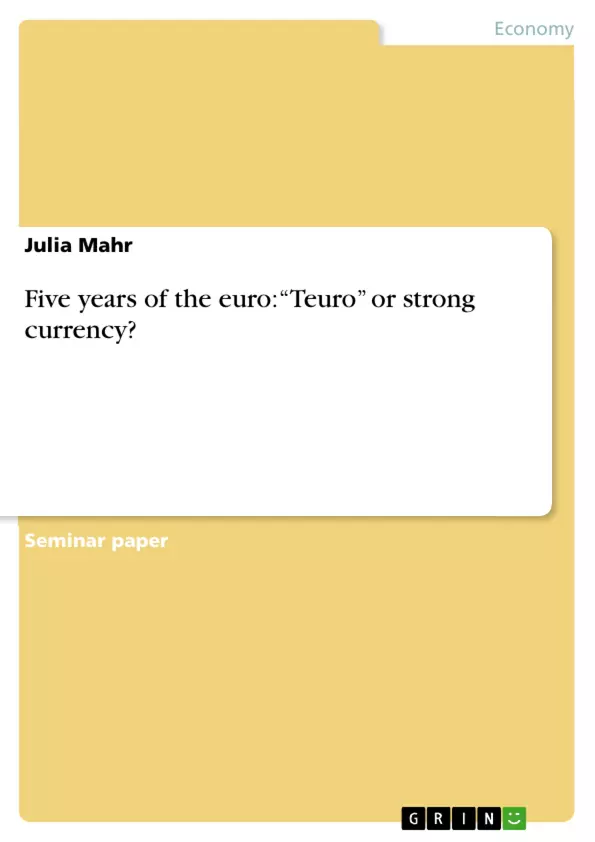The major event of introducing the single currency in 1999 did not have a great effect in daily life because the consumers in all twelve countries were still using their national banknotes and coins in payment transactions. Officially the euro replaced the national currencies, with the national currency units becoming sub-units of the euro but it existed only as scriptural or ‘book‘ money. That meant that first of all especially the world of business and finance began to use the euro in cashless operations. For them the transition happened immediately but on the other side for administrations and business the transition period took longer because they had to change their systems for accounting, pricing and payments over to the euro. To familiarise the people living in the euro-area-countries with the euro, dual pricing on labels was introduced and so the general public recognized the changing.
Inhaltsverzeichnis (Table of Contents)
- A. Introducing the euro
- 1. The introduction process
- 2. The Role of Information
- 3. Dual price displays
- B. What the euro caused
- 1. Advantages through the new institutions
- 2. The single market
- 3. The international role
- 4. Benefits and costs of adopting the euro
- 4.1 The Scandinavian Countries
- 4.2 United Kingdom
- 4.3. Arguments of the Yes- and No-campaigns
- C. An outlook to the future
- 1. More countries to come
- 2. Banknotes and coins in the future
- D. Conclusion
- 1. Consumer prices
- 2. Inflation
Zielsetzung und Themenschwerpunkte (Objectives and Key Themes)
This seminar paper aims to examine the impact of the euro, the single currency of the European Union, five years after its introduction in 1999. The paper analyzes the introduction process, the role of information and dual pricing, the advantages and challenges of the euro, and its impact on various countries.
- The introduction of the euro and its effects
- The role of information and dual pricing in the euro's adoption
- The economic benefits and costs of adopting the euro
- The impact of the euro on countries outside the eurozone
- The future prospects of the euro and its continued development
Zusammenfassung der Kapitel (Chapter Summaries)
- A. Introducing the euro
- 1. The introduction process: This chapter discusses the process of introducing the euro as the single currency of the European Union, highlighting the timeline of events, the responsibilities of the Eurosystem, and the role of national currencies.
- 2. The Role of Information: This section examines the significance of providing information about the euro to the public, highlighting the importance of addressing misconceptions and promoting understanding of the new currency.
- 3. Dual price displays: This chapter analyzes the effectiveness of dual pricing in the context of the euro's introduction, exploring its role in familiarizing the public with the new currency.
- B. What the euro caused
- 1. Advantages through the new institutions: This chapter discusses the economic benefits associated with the establishment of new institutions related to the euro, emphasizing its positive impact on the European economy.
- 2. The single market: This section examines the impact of the euro on the European single market, highlighting its role in promoting trade and economic integration within the EU.
- 3. The international role: This chapter explores the international implications of the euro, examining its role in global financial markets and its influence on other countries.
- 4. Benefits and costs of adopting the euro: This section analyzes the potential benefits and drawbacks of adopting the euro, considering the experiences of various countries and their perspectives on joining the eurozone.
Schlüsselwörter (Keywords)
This seminar paper focuses on the euro, the single currency of the European Union. It examines the economic and social implications of the euro, analyzing its introduction, adoption, and impact on various countries. Key themes include: European integration, monetary policy, economic growth, inflation, currency exchange rates, consumer behavior, and the impact of the euro on the global economy.
- Quote paper
- Julia Mahr (Author), 2007, Five years of the euro: “Teuro” or strong currency?, Munich, GRIN Verlag, https://www.grin.com/document/114001



